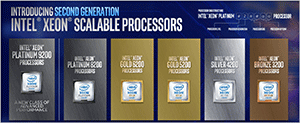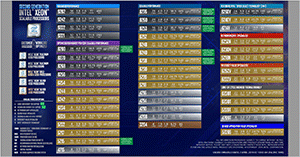In-Depth
Decoding the Latest Generation of Intel CPUs
Here's what the naming scheme means for the 2nd-Gen Xeon CPUs Intel released at the beginning of the month.
On April 2, 2019, Intel announced the release of a plethora of new CPUs in its latest generation of Xeon CPUs, which have been code-named "Cascade Lake." In this article, I explain the naming scheme Intel uses to identify these CPUs. If you want to read about the advanced features of these CPUs, I suggest reading this article.
The Cascade Lake generation of CPUs is the successor to Intel's Skylake and uses a 14 nm microarchitecture. Being based on the Xeon 2nd-Gen architecture, these CPUs are positioned for enterprise-grade servers and for computer enthusiasts. Intel brands its CPUs for the enthusiasts as Core i7 and Core i9 processors; for enterprise users, Xeon Bronze, Silver, Gold and Platinum. This article will only deal with the enterprise CPUs. The most exciting feature in this generation of CPUs is that some of the CPUs support Optane DC Persistent Memory (DCPM), which is a new tier of memory.
To better comprehend Intel's latest generation of CPUs, it's helpful to first understand Intel's naming scheme for these CPUs. To get a handle on how Intel codes its CPUs, let's look at the 6262V, a CPU that Intel is positioning to power servers for virtualization (Figure 1).
 [Click on image for larger view.]
Figure 1. The 6262V CPU. Source: Intel Corp.
[Click on image for larger view.]
Figure 1. The 6262V CPU. Source: Intel Corp.
To decode an Intel CPU chip, you need to understand that the first digit is the processor level, the second is the processor generation (all Cascade Lake CPUs are 2nd-Gen processors), the third and fourth digits specify the processor SKU, and the last one or two numbers specify any processor options that the CPU has (Figure 2).
 [Click on image for larger view.]
Figure 2. The Intel CPUs. Source: Intel Corp.
[Click on image for larger view.]
Figure 2. The Intel CPUs. Source: Intel Corp.
The first digit can range from three to nine and specifies the level of the CPU.
Models tagged as 32xx are Xeon Bronze CPUs. These are positioned at entry-level dual-socket servers and workstations, and although they're for price-sensitive applications that require light-range workloads, they still have enhanced security features. There's currently only one SKU for a Xeon Bronze system and it has six cores. These CPUs don't support Optane DCPM.
Models tagged as 42xx are Xeon Silver CPUs. These are positioned at midrange workload dual-socket servers, and have additional features, such as Hyper-Threading and Turbo Boost. They have between eight and 16 cores, and do not support Optane DCPM.
Models tagged as 52xx and 62xx are Xeon Gold CPUs. These are positioned at demanding workloads and support up to four-way multi-socket servers. The Xeon Gold CPUs offer high performance and high scalability, have between four and 28 cores, and do support Optane DCPM. Most of the CPUs that Intel has announced fall into this category.
Models tagged as 82xx and 92xx are Xeon Platinum CPUs. They're positioned to take on the most demanding workloads and support up to eight-way multi-socket servers. The Xeon Platinum series has Intel's Xeon chip with the highest performance, scalability and flexibility. These CPUs have between 16 and 56 cores, and also support Optane DCPM. Additionally, a specific feature available only to Platinum models is its eight-way multi-processing support.
The third and fourth digits specify the processor SKU; the higher the number, the more performant the CPU will tend to be. For example, the 6262V is more powerful than the 6222V, as the former has 24 cores with a base speed of 1.9 MHz and the latter has 20 cores running at 1.8 MHz.
The two letters at the end of the CPU SKU indicate any special features that the CPU may have; for example:
- L – Support for large DDR memory (up to 4.5TB)
- M – Support for medium DDR memory (up to 2TB)
- N – Network-optimized CPUs
- S – Search engine
- T – Thermal and long lifecycle
- V – VM density value
- Y – Speed Select technology
So, to recap, the Intel CPU that I mentioned at the beginning of this article, 6262V, is a Xeon Gold CPU (62xxx) in the top of the performance tier (xx62x) for the Gold CPUs and is a VM density value CPU (xxxxV).
Figure 3 shows a list of all the 2nd-Gen CPUs Intel announced on April 2, 2019.
 [Click on image for larger view.]
Figure 3. The entire list of Xeon 2nd-Gen CPUs. Source: Intel Corp.
[Click on image for larger view.]
Figure 3. The entire list of Xeon 2nd-Gen CPUs. Source: Intel Corp.
About the Author
Tom Fenton has a wealth of hands-on IT experience gained over the past 30 years in a variety of technologies, with the past 20 years focusing on virtualization and storage. He previously worked as a Technical Marketing Manager for ControlUp. He also previously worked at VMware in Staff and Senior level positions. He has also worked as a Senior Validation Engineer with The Taneja Group, where he headed the Validation Service Lab and was instrumental in starting up its vSphere Virtual Volumes practice. He's on X @vDoppler.